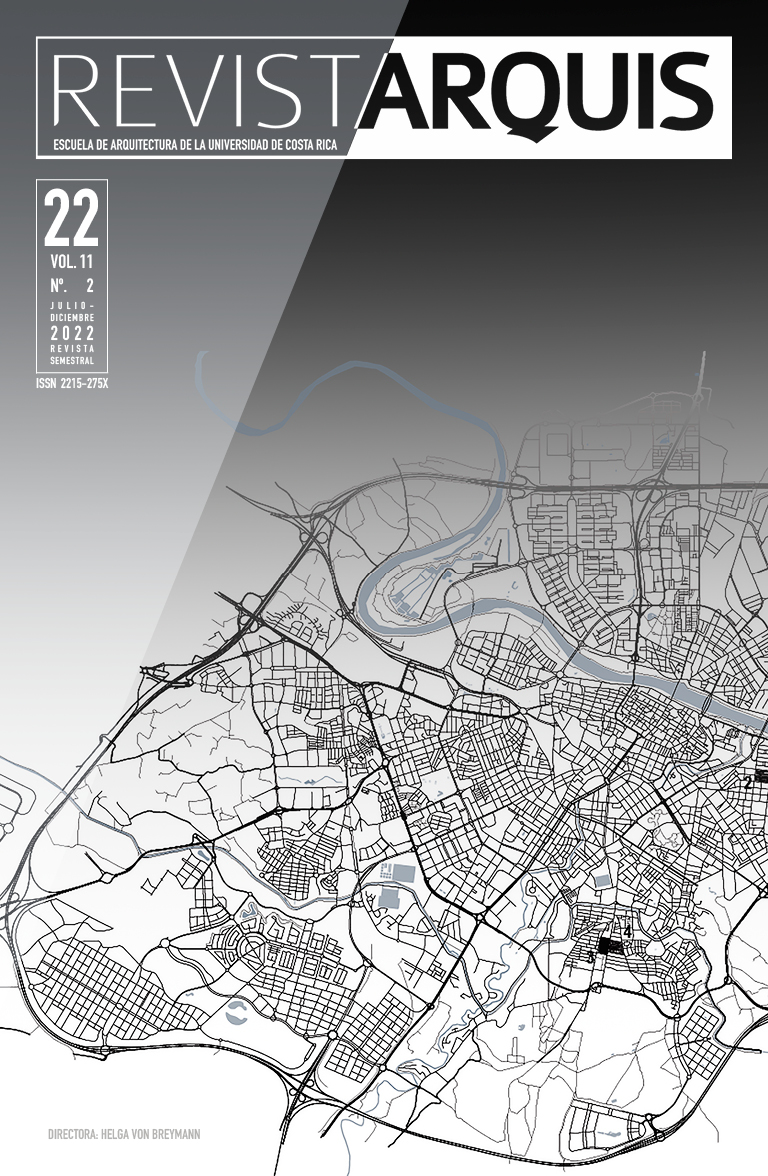Abstract
Community participation and political action in urban transformation is the central approach in this discussion, which also arises from practices, images and social knowledge in the encounter between the architecture of the city as a stage and everyday urban life as the symbolic component that reveals identities in the thread of intercultural meanings. The purpose is to support community participatory urban design processes based on the socio-aesthetic analysis of urban life, understood as an epistemological, theoretical and methodological approach for urban transformation from collective dialogue. Among the findings, a series of categories of analysis were obtained, namely: sociocultural historical analysis, analysis of urban life as daily praxis, characterization of the environmental quality of the space given the local territorial conditions, ordering of security and control technologies, and the popular production of public policies of urban space considering public policies. The research carried out in the historic center of Santa Lucía emphasizes the relationship between space-time, everyday life and urban architecture, determinant to think of an intercultural urbanism centered on community dialogues built with, from and for the people, strengthening participation and political action in the creation of urban spaces that respond to the needs and demands of the communities.
References
Bourdieu, P. (2002). Razones prácticas. Sobre la teoría de la acción. Editorial Anagrama.
Cortés, J. M. (2010). Malas Calles en Institut Valencià d’Art Modern -IVAM-. Catálogo exposición Malas Calles (pp. 13-35). LA IMPRENTA CG.
Cortés, J. M. (2006). Política del espacio. Arquitectura, género y control social. Institut d’Arquitectura anvançada de Catalunya.
Cottino, P. (2005). La ciudad imprevista. El disentimiento en el uso del espacio urbano. Edicions Bellaterra, S.L.
De Certeau, M. (2010). La invención de lo cotidiano. 1 Artes de hacer. Universidad Iberoamericana.
Fuenmayor, S., Iazzetta, E. y Pérez Jiménez, C. (2016). Espacio, praxis y familiaridad. MULTICIENCIAS, 16(1), 39-48. https://www.produccioncientificaluz.org/index.php/multiciencias/article/view/22365/22065
Hall, E. (1978). Más allá de la cultura. Editorial Gustavo Gilli, S.A
Heller, Á. (2002). Sociología de la vida cotidiana. Ediciones Península.
Harvey, D. (1977). Urbanismo y desigualdad social. Siglo XXI Editores S.A.
Iazzetta Di Stasio, E. y Pérez Jiménez, C. (2014). Cuando las ciudades sean interculturales. Cuadernos Latinoamericanos, 25, 87-107.
Iazzetta Di Stasio, E. (2008). Experiencia socioestética en los frentes de agua. [tesis doctoral, Universidad del Zulia de Venezuela].
Lindón, A. (2000). Del campo de la vida cotidiana y su espacio-temporalidad: una presentación en A. Lindón (coord.), La vida cotidiana y su espacio-temporalidad (1ª ed., pp. 7-18). Anthropos Editorial.
Pérez Jiménez, C. (2022). Trazos geopolíticos para la descolonización de las territorialidades latinoamericanas. Revista Estudios, Núm. 44, 1-27, https://doi.org/10.15517/re.v0i44.
Pérez Jiménez, C., Iazzetta Di Stasio, E., Reyes Labarca, S., Millan, I. y Soto, A. (2016). Memorias de la Visibilidad de Santa Lucía. Tomo 1: Santa Lucía, Palabra Hecha Historia. Colección Santa Lucía Visible. Fondo Nacional de Ciencia Tecnología e Innovación.
Porto-Gonçalves, C. (2009). Territorialidades y lucha por el territorio en América Latina. Geografía de los movimientos sociales en América Latina. Ediciones IVIC.
Romero, J. L. (2008). Latinoamérica, las ciudades y sus ideas. Siglo XXI Editores.
Santos, M. (2000). La naturaleza del espacio. Técnica y tiempo. Razón y emoción. Editorial Ariel S.A.
Santos, M. (2012). Por uma economia política da cidade. O caso de São Paulo. Editora da Universidade de São Paulo.
Sassen, S. (2007). La ciudad global: emplazamiento estratégico, nueva frontera. http://data.over-blog-kiwi.com/1/38/03/91/20150819/ob_4565c7_antologa-a-de-textos-sobre-antropologa.pdf
Sassen, S. (2003). Los espectros de la globalización. Fondo de Cultura Económica de Argentina S.A.
Sennett, R. (2007). Carne y piedra. El cuerpo y la ciudad en la civilización occidental. Alianza Editorial.
Comments

This work is licensed under a Creative Commons Attribution-NonCommercial-NoDerivatives 4.0 International License.
Copyright (c) 2022 César Augusto Pérez Jiménez


